Preprints & Reprints
Back to Preprints & Reprints > Publications & Opinion > Homepage
THE RIGHT IDEA AT THE RIGHT TIME
Peter Cochrane and David J T Heatley
Abstract
Telecommunications in the UK is almost unique in the Western World with 100% availability of ISDN service, digital transmission and switching of all trunk circuits and direct customer dialling facilities to all regions of the UK and over 129 countries. British industry today enjoys access to more wide band (2 Mbit/s and above) circuits than the rest of Europe in absolute terms, and more than the rest of the world per worker employed. All of this was predicated by the very early decision to replace the coaxial cable and microwave radio network with optical fibre. Today there is an installed base of over 2 x 106km of single mode fibre in the UK, linking all of the network nodes with a medium that can offer an almost infinitely expandable transport capacity. This fibre now carries over 80% of all UK telecommunications traffic and 65% of international connections. Achieving this advance was the result of timely R&D programmes coupled with strategic decisions on the infrastructure and investment profiles. To date optical network technology has saved the UK several ?Bn in providing an almost unique telecommunications service. In the future this will be enhanced further through the introduction of optical (photonic) amplification and signal processing which will reduce the dependency on electronics and realise a transparent network. In turn this will herald a partial return to analogue forms of transmission and switching, thereby bringing about with further dramatic reductions in the number of network nodes, equipment, maintenance and operating costs, whilst increasing the network flexibility and utility.
These developments have placed extra emphasis on the study of services and facilities that can be provided now and in the far future, as well as drawing attention to such major issues as software reliability and forms of realisation. In this paper we will briefly review the optical fibre story to date, and then go on to map out the near and far future developments that will allow the provision of radically new telecommunications services.
1 Genesis
The history of telecommunications has seen a remarkable progression of technology meeting mankind's needs, with an accelerating ability to transport information at lower power and material costs year on year. As each technology has saturated at some fundamental capacity limit, it has been overtaken in a timely manner by some spectacular (and usually unexpected) advance. This trend is illustrated in Fig 1for line transmission systems. Here we see the limits of open copper conductors overtaken by loaded twisted pair cables. These are then surpassed by electronic amplification, Frequency Division Multiplex (FDM) and Time Division Multiplex (TDM) on twisted pair and coaxial cables. By 1960 it was becoming apparent that these cable based technologies would present limits to further progress and growth within a decade or two. The fundamental capacity in terms of the number of simultaneous telephone calls that could be carried, coupled with the basic cost in raw materials, physical space, power and investment was set to create barriers to further progress. With hindsight this situation can now be seen to have posed a significant threat to the progress of the UK and global economy.
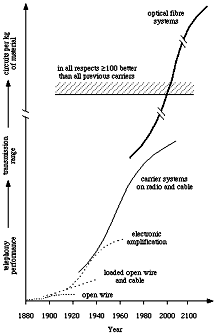
Fig 1. Logistic curve for future transmission system development
One solution to the transmission capacity limit of copper cables and microwave radio that was avidly pursued in the 1970's was that of Trunk Wave guide. A 50 mm diameter helically coiled wire inside a resin based pipe was shown to support a transmission bandwidth of some 60 GHz with relatively low loss. Repeater sites at 15 km intervals were demonstrated to be possible provided the radius of curvature along the route was did not exceed 100 m or so. This represented a significant advance over the 2 km repeater spacing required by copper cables, and the economics looked sufficiently attractive for wave guide networks to be planned in the UK, France and the USA. However, the technology demanded costly civil engineering, with laser alignment of ducts and ?straight line? deployment for optimum performance. Nevertheless, development and planning progressed to an advanced stage, production plants for the wave guide were constructed, and the technology was at the point of being launched on a national scale as a backbone trunk system, when it was eclipsed in the mid/late 1970's by the arrival of low loss optical fibre.
Interestingly, optical fibre is also a waveguide, but of a much smaller diameter (~125 um) to support the higher carrier frequency (~1014 Hz) of light. Among it?s key features are: very small size, very low material usage, low production costs, an ability to use existing cable ducts, a potential for very low loss coupled with a wide bandwidth (high traffic capacity). In the early days of fibre it was not evident just how dramatic these advances would become, or to what extent they would impact on the national and global economy.
2 Key Decisions
During the last two decades a number of key decisions were taken which have proved to be responsible for the radical changes in national and global telecommunications that we all benefit from today.
Key Decision 1
During 1972-77 the then British Post Office (BPO) made two fundamental decisions: to go for a wholly digital network and to base it on optical fibre transmission technology. Major R&D programmes were launched in both switching (System X) and fibre system realisation. Each month saw fundamental breakthroughs in the basic technology of fibre and device fabrication, performance and application. The fibre loss fell rapidly while the demonstrable capacity increased (Fig 2), in each case figures being achieved that were very close to fundamental limits. It soon became apparent that buried repeaters would not be required, which in turn brought about significant reductions in the maintenance and management load compared with copper cables.

Fig 2. Principal trends in cable telecommunications
Key Decision 2
By 1980 a number of system trials had been completed with British industry using two different fibre types: multi-mode and single-mode. The former had a larger central core (~50um) and was relatively simple to handle and joint with connectors or splices, whilst the latter had a very small core (~8um) and was proving more difficult to joint. However, the bandwidth of multi-mode fibre was found to be severely limited due to the multi-path dispersion of the propagating light pulses, whereas single-mode fibre suffered negligible dispersion and so offered an almost infinite bandwidth. At this point the decision on which fibre to deploy was pending, but by 1981 the Japanese had decided to opt for multi-mode, quickly followed by much of North America and most of the rest of the world. However, the BPO decided to go single-mode for all applications in the UK network. This had two key consequences: all R&D became focused on solving the problems of the one technology rather than two, and UK industry only had to produce single mode fibre and devices. As a result the UK was able to realise state of the art systems at a lower cost, and in an earlier time frame than any other nation. Most of the North American players reversed their decision within 12 months in the light of significant R&D advances, whilst the Japanese continued to pursue the multi-mode route for a further three years.
Key Decision 3
In 1981 the BPO took the decision to modernise all aspects of it?s long and medium haul transmission networks by the ubiquitous installation of single mode fibre that was optimised for operation in the 1.3 um window. Problems associated with fibre jointing, splicing, connectors and devices thenhad to be solved.
Key Decision 4
Since the geographic distribution of all BPO building stock (offices, radio stations, switching and repeater sites) was at the time such that interconnection distances were less than 35 km, systems were specified to have a single-span transmission distance that met/exceeded this figure, thus obviating the need for expensive buried repeaters and associated power feed equipment. By the mid 1980's this decision was further endorsed by the demonstration of research systems with a 100 km span.
Key Decision 5
The first production systems operated at 140 Mbit/s between the major trunk nodes (switching) centres. This immediately brought about major operational improvements in terms of lower maintenance cost, fewer outages and better tolerance to external interference. At the same time R&D system trials were realising 4 times this bit rate over the same repeater span. By 1985 the decision had been taken to uprate systems to 565 Mbit/s, which in turn reduced the cost per bit transported by better than 1/3.
Key Decision 6
While fibre technology was being deployed, a series of developments led to the use of fusion splicing, as opposed to mechanical and/or epoxy based joints. This is still the case today. One of the many benefits is that the BT network is intrinsically capable of future upgrading to Duplex (bi-directional) operation at the same wavelength (with or without optical amplification) by virtue of the low loss/reflection of joints. This is not the case in many other countries where the use of non-fusion splices has resulted in high reflections and other problematic features.
Key Decision 7
The decision in the late 1980's to extend fibre systems to every switch site in the BT network has radically improved the performance of the network in all respects. Today the network is 100% digital in the transmission and switching of long lines calls, with over 80% of the traffic carried on optical fibre.
Key Decision 8
The next logical step would have been to extend fibre into the local loop. However, the regulatory regime in the UK has, so far, rendered this step non-viable for all but the medium and large corporate customers. Direct fibre deployment to these customers is now underway and R&D for local loop systems is well advanced,. For example, the development of Passive Optical Networks and their demonstration at Bishop Stortford and Birmingham has already validated the base technologies.
Key Decision 9
A four-fold increase in the base bit rate to 2.4 Gbit/s is now planned with the same repeater spacing as for the previous 140 Mbit/s and now dominant 565 Mbit/s systems. This should see a further 1/3 cost reduction per bit carried, and will be coupled with a move to synchronous working, a streamlining of the software loading, and a reduction in the number of network nodes (switches).
It is worth noting that, even if today's state-of-the-art 10 Gbit/s systems were to be deployed, the utilisation of fibre bandwidth is unlikely to reach even 10% for some years (Fig 3). Indeed, it is reasonable to visualise the enormous capacity of fibre satisfying telecommunication needs well into the next millennium.
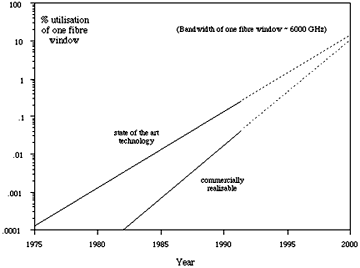
Fig 3. Utilisation of fibre bandwidth with time
3 WHAT NEXT ?
The above historical perspective highlights the giant leap in technological capability compared with the copper past, however the story is far from at its end. As the R&D on optical fibre systems continues we might expect to see even more dramatic advances over the next decade or two.
The Optical Amplifier
Arguably the most significant of recent developments has been the optical amplifier. When used as cable repeaters, not only do they reduce the component count in the transmission path, which has clear benefits to reliability and running costs, but they also open up the full bandwidth of the fibre windows (~6,000 GHz with today's technology, which compares with ~100 MHz for a good copper cable - an improvement of more than 4 orders of magnitude!). They also allow the development of novel transmission and network concepts that take full advantage of the linear and non-linear properties of fibre.
The first optical amplifiers successfully developed were based on semiconductor lasers. Their structure gives rise to certain fundamental features which limit their overall performance and have detracted from their widespread use. Nevertheless, through their small size and GaAs material base they are now receiving attention with regards to their integration with other GaAs devices and wave guides to form opto-electronic IC's.
The majority of today's developmental work is devoted to Erbium doped fibre amplifiers (EDFA) since they can readily realise all the features crucial to high performance transmission systems. Furthermore, their principal parameters are defined by atomic composition rather than physical geometry as with the semiconductor variety, which means that consistency (and hence yield) during manufacture is high. Their realisation is simple, involving the direct doping of a silica fibre core to provide a medium which affords gain when optically pumped at an appropriate wavelength.
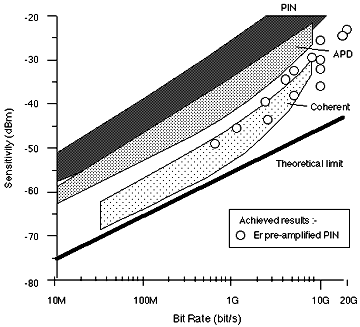
Fig 4. Best reported receiver sensitivities
EDFA's are capable of realising a noise figure close to the 3 dB theoretical minimum, which renders them attractive as receiver pre-amplifiers to improve sensitivity.Fig 4 summarises the best sensitivities reported from which it is clear that substantial improvements (?20 dB) can be achieved over un-amplified receivers. It should be noted that the sensitivity of pre-amplified receivers exceeds that of coherent systems at high bit rates: this represents a major cost advantage.
The Black Box
It is important to recognise that we have become conditioned to viewing repeaters and amplifiers as discrete entities: the "black box". With the advent of fibre amplifiers has come the prospect of distributed amplification, where the cabled fibre itself provides gain. Under these circumstances transmission is truly lossless. Furthermore, theory predicts that distributed amplification is optimal regarding noise accumulation: an echo of our earlier analogue FDM heritage! Experiments have successfully demonstrated lossless transmission over distances of 50 km and beyond.
International Systems.
Clearly fibre amplifiers in either discrete or distributed form will be central to future transmission routes and networks. For example, the TAT-12 and TAT-13 transatlantic systems, scheduled for service in 1995 and 1996 respectively, will each utilise discrete EDFA's throughout their ~6,500 km length. They will provide 5 Gbit/s capacity per fibre between the UK and the USA, and France and the USA respectively: at least 10 times the capacity per fibre of today's transatlantic systems.
Soliton Systems
A new generation of transmission systems that exploit rather than fight against the non-linear properties of fibre are at an advanced R&D phase. The key to these systems is the Soliton: a particular pulse shape which, when correctly launched into the fibre, maintains its shape as it propagates: linear distortion (pulse spreading through dispersion) exactly cancelling non-linear portion (pulse narrowing). After a certain distance solitons do eventually succumb to attenuation and dispersion and so break down. However, by placing optical amplifiers at critical intervals along the cable, or better still by using distributed fibre amplification, pulse breakdown is avoided.Fig 5 summarises the key bit rate/distance achievements in laboratory trials to date and multi-Gbit/s transmission over international distances is clearly possible.
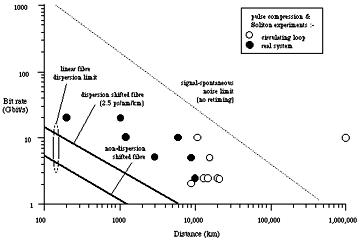
Fig 5. Bit rate -v- distance achievements using solitons
The Optical Ether
If we consider exploiting the bandwidth of fibre in a similar manner to the radio spectrum in mobile communications, we rapidly migrate towards an Optical Ether as shown in Fig 6. To address an end point terminal all that is required is the area wavelength (not area code) and the final (fine grain) wavelength for WDMA, frequency for FDMA or code in the case of CDMA. Related studies have shown that this approach could be extended to the replacement of the central office for up to 200,000 lines with a 100% non blocking capability, with potential for improvement to 4-million lines. At today's service levels with a similar level of call/service blocking, up to 20-million lines could then be accommodated, with a potential for significantly more. Beyond this level the need for conventional switching of some kind becomes necessary again.
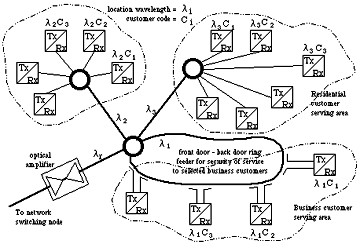
Fig 6. The optical ether concept
The ether concept has been demonstrated in the laboratory with a small number of terminals switching 100 Gbit/s capacities, and in the London fibre network with more modest capacity levels. The key problems and limitations now hinge on the realisation of sufficiently miniature and reliable electro-optics, memory capacity, control systems and wavelength standards. The rate of developmental progress towards all of these requirements currently puts commercial realisation in the 2010 time frame.
Another interesting prospect for transparent networks is that of customer mobility. It is possible to transport raw microwave signals over fibre with only a single stage of frequency translation at each end. A radio cell can therefore be replicated over several remote and diverse locations to give the illusion of a single location. Effectively six dispersed company locations start to appear as one to the individual user. The certainty of this prospect increases with the realisation that optical wireless is also being developed for in-building and street use for both telephony and broadband services.
The Optical Bus
The concept of distributed amplification with Erbium doping can be applied to the data bus. For example, the optical equivalent of a ?tapped bus? has been demonstrated using D-fibre couplers in a network of weakly amplifying fibre (Fig 7). Although noise accumulation will eventually dominate, it is nevertheless feasible that such a bus could grow to accommodate >1000 taps. This, coupled with the ability to use fibre amplifiers to offset splitter loss in an optical branching network that fans-out to several million customers opens up the concept of the VirtuallyLOssless Network (VLON) at all levels: metropolitan, national and international.
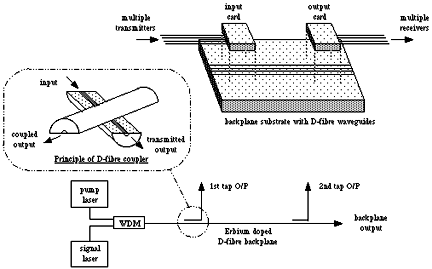
Fig 7. Amplified optical backplane/bus using Erbium doped D-fibres
Analogue -v- Digital
The history of telecommunications has undergone cyclic changes with regard to the use of analogue and digital transmission (Fig 8). The earliest form of digital transmission: telegraphy using Morse Code, was replaced by analogue transmission over a century ago with the arrival of the telephone. Analogue remained dominant in a FDM form up until the late 1950's at which point digital PCM was introduced. Within three decades the balance had inverted, with digital TDM substantially dominating over analogue. Today there is a hint of a return to analogue, or perhaps a converging ofTDM and FDM. This follows from the extensive interest in the use of Sub-Carrier Modulation (SCM) to assemble large multiplexes of channels. When combined with WDM it affords a convenient way of increasing the utilisation of fibre without recourse to the high speed electronics and elaborate synchronisation needed for digital working.
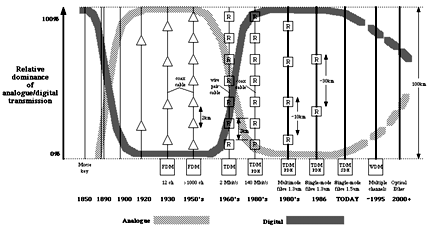
Fig 8. Cyclic trend in Analogue -v- Digital transmission
Optical Processing and Computing
The use of optical technology in storage and signal processing is becoming common place in certain application areas: witness optical hard disks for personal computers and domestic CD players. The impact of optical processing on telecommunications has yet to be experienced but is likely in time to ve as profound. For example, optical processing will provide a major input to neural network development. Indeed, many research-level neural networks are being realised in optical components. The main reason for this is the ability of optics to offer massive parallelism and interconnections. Since these parameters are fundamental to the principles of neural computing, optics is clearly suitable, so much so that the technologies are likely to develop very closely.
There are many incentives to migrate towards optical processing. The principal advantages are the potential for high speed with massive connectivity and low power consumption. For example, a massive 10 12 parallelism may be realised in an optical processor, using a holographic element, a 1 million element lens array, SpatialLight Modulator (SLM) and a million element detector array. By combining such parallelism with the developing ability to construct holograms by computer in real time, the true potential of optical computing then becomes visible.
Fibres can also afford a degree of storage and optical processing by virtue of "structures" than can be written into their cores as variations in the refractive index. For example, a grating structure gives the fibre a wavelength dependent attenuation which, in its simplest form can realise an optical filter, or in a more complex form an equaliser to flatten the frequency response of an optical amplifier.
4 Final Comments
In less than 20 years optical fibre has revolutionised the global telecommunications network. In the UK this has been realised through the timely initiation of R&D programmes coupled with the planning and deployment of systems developed and manufactured by UK companies. In most respects both BT and industry have enjoyed a lead that has seen the UK profit through the realisation of a network and services that are advanced by any standard. During the next 20 years optical fibre technology can be expected to impact even more prominently by realising new and revolutionary networks, services and applications. A focused R&D activity has placed BT in a pre-eminent position to exploit these possibilities for the UK as we go into the next millennium.
The realisation of network capacities that are orders of magnitude beyond those of today will be essential to service the growth in both fixed and mobile telecommunications. To ve specific:
- Computer capacity will increase by 1000 fold in the next decade, and 1,000,000 fold in the decade that follows. At the same time clock rates will increase by 10 and 100 fold respectively.
- Distributed computing is only effective with wide bandwidth channels between computers that are capable of data transfer rates on a par with the internal delays of the computers involved.
- The number of mobile units is expected to increase by 10 - 20 fold over that of today in the same time frame.
- The teleportation of human senses: voice vision and touch, is already well developed and will be required to meet the need of all sectors as they try to maximise the utilisation of highly skilled and qualified staff.
- Usurping physical travel with telecommunications will become a necessity through diminishing natural resources.
- Controlling and servicing the global economy will demand improved telecommunications and computing.
- The introduction of Virtual Worlds technology is probably just the tip of an iceberg of new services that we could broadly classify as "not invented/thought of yet".
The network decisions and developments necessary to ensure that the infrastructure is available to service this latent and developing demand include:
- A consolidation of switching nodes in the BT network from > 6000 to <100.
- The deployment of Passive Optical Networks in the local loop.
- The deployment of optical amplifiers to realise network transparency.
- The deployment of new forms of software to reduce the massive risk build up due to unnecessary complexity.
- The introduction of WDM as a switching mechanism to replace TDM and SDM.
- The realisation of new fibre based devices that will simplify the coding, selection and switching processes.
- A migration away from digital back towards analogue signal formats, modulation and signalling.
- The introduction of pre-emptive fault/failure forecasting and diagnosis.
All of the technologies to realise such a revolutionary change in the next 10 - 20 years has been, or is currently being researched and proven. Probably the major challenge will be their planning and phased introduction to meet the increasing demand for more bandwidth and new services.
The recent trend of consumer electronics leading the high technology industries in the development of applications, both at the forefront of the technology capability and in a very short time frame, poses a significant challenge. Unless the telecommunications industry realises networks that are far more versatile, progress will stall. In this respect the UK position looks more favourable than most to keep ahead of the game.
Further Reading
COCHRANE P: 'Future Trends in Telecommunications Transmission - A Personal View', IEE Proc, Vol 131, P + F, No 7, Dec 84, pp 669-683.
COCHRANE P and BRAIN M C: "Future Optical Fibre Transmission Technology and Networks", IEEE Communications Magazine, 26/11, Nov 88.
COCHRANE P: 'Future Directions in Long Haul Fibre Optic Systems', BTTJ, 8/2,April 90, pp5-17.
COCHRANE P, et al: Computing and Comms - The Next Decade, IEE 3rd Bangor Symp on Comms UCNW, Bangor, North Wales, May 91 pp 50-56.
COCHRANE P, et al: Optical Telecommunication Future Prospects, IEE Vac School on Optical Fibre Communications, UCNW Bangor, July 1992.
COCHRANE P, et al: CamNet - The First Telepresence System. INTERLINK 2000 Jnl, Aug 1992, pp 38-41.
COCHRANE P and HEATLEY D J T: Optical Fibre Systems & Networks in the 21st Century. INTERLINK 2000 Jnl, Feb 1992, pp.150-154.
COCHRANE P, et al: The Office You Wish You Had, IBC Conference on Advanced Office Systems, Cafe Royal, London 12 Oct 1992
COCHRANE P: Copper Mind Sets, NEC Infovision Comforum Futures Conference, Orlando, Florida, Nov 1992.
COCHRANE P: The Human Machine Interface & Telepresence NEC Infovision Comforum Futures Conference, Orlando, Nov 92.
COCHRANE P: The Human-Machine Interface & Telepresence, Euro Conferencing Jnl, Vol 1, Issue 2, Winter 1992, pp 48-5
O?MAHONY M J: Semiconductor laser optical amplifiers for use in future fibre systems, IEEE JLT, 6/4, April 1988, pp. 531-544.
OLSSON N A: Semiconductor Optical Amplifiers, Proceedings of the IEEE, 80/3, March 1992, pp. 375-382.
Optical Fibre Lasers & Amplifiers, edited by P W France, Blackie, 1991.
HILL, A.M: Network implications of optical amplifiers, OFC'92, San Jose, USA, 2-7th Feb'92, paper WF5.
CHIDGEY P J, et al: Wavelength routing for long haul networks, ICC'89, Boston, June'89, pp. 23.3.
WAY W I, et al: Sub-carrier multiplexed lightwave system design considerations for subscriber loop applications, IEEE JLT, 7/11, Nov'89, pp. 1806-1818.
WRIGHT J V, et al: Constraints on the design of long haul soliton systems, OSA meeting on Non-linear Guided Wave Phenomena, Cambridge, USA, Sept'91.
BOGGIS J M, et al: Opening the 1.5um window in 1.3um regenerated system, IEE Electronics Letters, 27/2, 1991, pp. 129-130.
ROTTWITT K, et al: Design of long distance distributed Erbium doped fibre amplifier, IEE Electronics Letters, 28/3, January 1992, pp. 287-289.
WHITLEY T J, et al: Demonstration of a distributed optical fibre amplifier bus network, Topical Meeting on Optical Amplifiers and their Applications, Monterey, California, 1990, paper WB2.
CAULFIELD H J: Computing with light, Byte, October 1989.
CAMPBELL R J, et al: Optical data storage in photosensitive fibres, SPIE Proceedings on Optical Data Storage'91, Colorado, 25-27th February 1991, Vol. 1499, pp. 160-164.